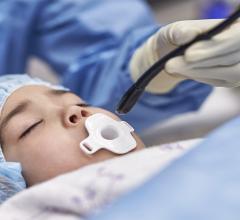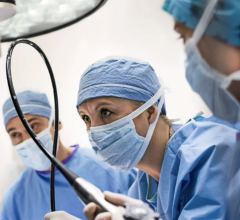June 25, 2007 - Philips demonstrated the new Live 3D transesophageal echocardiogram (TEE) probe, the X7-2t, at the 18th Annual American Society of Echocardiography (ASE) Scientific Sessions in Seattle.
Live 3D Echo, which has been delivering data to cardiologists to aid in diagnosis and planning, has been transitioned to a TEE probe, enabling cardiologists, cardiac surgeons, anesthesiologists, cardiac interventionalists and echocardiographers to view new depths of data with the X7-2t transesophageal transducer.
Available soon on the iE33 system, Live 3D TEE is the result of combining and miniaturizing two cutting-edge technologies. With the 3D power of xMATRIX technology and the image clarity of PureWave crystal technology in one transducer, new views of cardiac structure, pathology and function can be seen. These views provide additional information for diagnoses, treatment planning, monitoring and assessing during procedures and follow-up.
In addition, Live 3D TEE imaging provides more perspectives of the heart, including the surgeon’s view–a perspective of the mitral valve from the left atrium as well as from the left ventricle. The 3D heart is displayed in motion, in real time. This fast and easy real-time 3D image display reduces the need to reconstruct pathology from multiple 2D views. Live 3D TEE provides clinicians with more information for diagnostic and decision-making steps, while also being a superb communication tool.
Live 3D TEE is designed to deliver high image quality, accurately depicticardiac structure, pathology and function, which allow cardiologists to confidently diagnose and plan treatment. Live 3D TEE is on-the-spot evaluation, and there may be no need for further exams or tests. Communication is facilitated, as these images contain the information surgeons, anesthesiologists and cardiac interventionalists need and understand.
Surgeons and anesthesiologists can see the complete mitral valve from multiple perspectives while it’s functioning with Live 3D TEE. A comprehensive plan can be in place before the first incision. Live 3D TEE images enable assessment of valvular function views not available once surgery begins. During surgery, anesthesiologists easily monitor patients, perform analysis for surgeons, such as quantify the mitral valve with new and objective data, and assess procedure outcomes to determine if fully resolved. If needed, further repairs can be done immediately before completing the procedure.
Interventional cardiologists have more information for procedures such as device implantation, closing ASDs and PFOs with Live 3D TEE, as well as improved visualization during guided procedures.
QLAB quantification with Live 3D TEE provides both left ventricular wall motion analysis for echocardiographers, and all new 3D mitral valve quantification for precise information. With 3D mitral valve quantification, clinicians have mitral measurements that are simply not possible with 2D techniques.
According to Roberto Lang, Professor of Medicine at the University of Chicago, director of Cardiac Non-invasive Imaging Laboratories, patients are the real benefactors of Live 3D TEE imaging. “I actually think that this allows us to do our current work in a probably more effective type of way, so I think that the person who is going to benefit more is the patient because the people working, the health providers of this patient will have better information and would be able to know what to do with more certainty.”
For more information: www.medical.philips.com/us/


 June 13, 2024
June 13, 2024 







